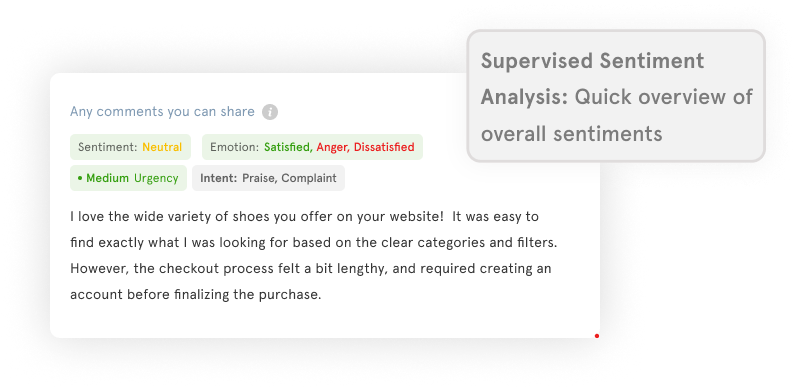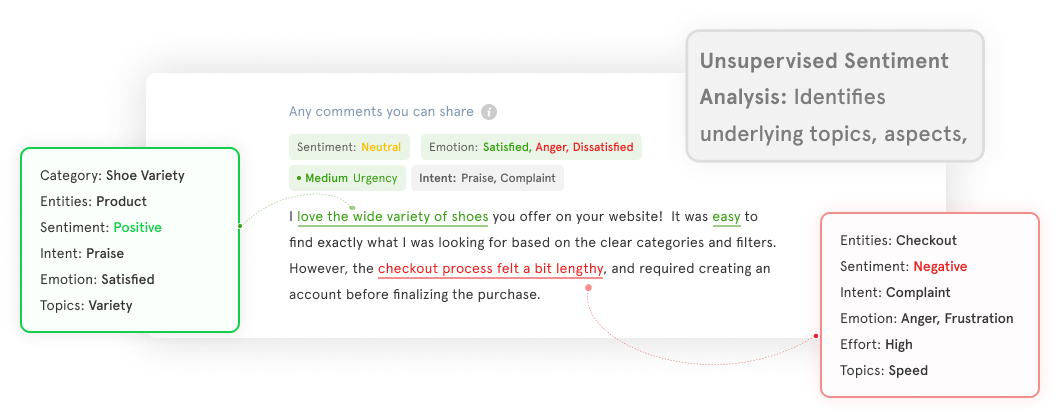Analyzing sentiments using models trained on labeled feedback data such as CES, CSAT, and Net Promoter Score is a well-known practice in sentiment analysis. However, the real challenge emerges when dealing with unstructured or unlabeled data from open-ended comments.
And with over 80% of the CX data within enterprises being unstructured, the challenge cannot be overlooked.
This is where unsupervised sentiment analysis comes in.
With unsupervised learning models for sentiment analysis, enterprises can get a nuanced view of customer attitudes, sentiments, behavior trends, and even operational bottlenecks from all kinds of customer data and not just one with labels, formats, and structure.
The Machine Learning and Natural Language Processing algorithms trained on unstructured data can extract crucial insights that are otherwise hard to identify within text comments, reviews, feedback, and more.
TL;DR
- Unsupervised sentiment analysis is the process of analyzing open-ended, unlabeled feedback—like survey comments, reviews, or chat transcripts—to detect customer sentiment without needing pre-tagged data.
- Because most customer feedback is unstructured and unlabeled, Unsupervised analysis helps you extract insights from it at scale, in real time, and without manual tagging.
- Unlike supervised methods that rely on labeled training data, unsupervised sentiment analysis uses AI to discover patterns, themes, and emotions on its own—making it faster and scalable.
- The different techniques used in analyzing unsupervised sentiment include lexicon-based models, clustering, topic modeling (like LDA), graph-based methods, and word embeddings.
- Zonka Feedback is a voice of customer tool that makes it easy to analyze sentiment from unstructured feedback using features like AI sentiment analysis, theme classification, smart summaries and more. You can schedule a demo to learn more about it.
Extract Sentiment from Unlabeled Feedback at Scale
With unsupervised sentiment analysis tool, uncover emotion trends, surface hidden themes, and make smarter CX decisions.

Understanding Unsupervised Sentiment Analysis
To understand unsupervised sentiment analysis, we’d have to first get acquainted with the technique- sentiment analysis.
In order to grasp the concept of unsupervised sentiment analysis, it is essential to familiarize ourselves with the technique known as sentiment analysis.
Often termed opinion mining, sentiment analysis is the process of analyzing text to determine the sentiment or emotional tone expressed within. The main objective of sentiment analysis is to automatically classify text as positive, negative, or neutral based on the emotions conveyed by the words.
It gives businesses the power to extract valuable insights from large volumes of text data.
This text data can be broadly categorized into two parts: structured or unstructured data, depending on the sources, formats, and, of course, the structure.
Responses to questions with scales, buttons, choices, etc., such as CSAT, NPS, or CES, are categorized as structured data. At the same time, any type of feedback received on open comment boxes is unstructured.
What unsupervised analysis does is it breaks down the unsupervised text data to extract meaningful insights and action plans.
For instance, feedback received on a luxury jewelry site wouldn't highlight all the sentiments hidden in the customer's response if it wasn't for an open-ended question.
Unsupervised sentiment analysis helped identify the sentiments, emotions, intent, and a lot of other aspects of the feedback that would've gone unnoticed otherwise.
Unstructured data refers to data that does not have a predefined format or organization, such as text documents, social media posts, customer reviews, emails, and more.
For example, a comment like "The service was great. We would love to visit again" shows a positive sentiment. At the same time, something like "The interface was cluttered and I was unable to complete the transaction" denotes a negative sentiment.
In unsupervised sentiment analysis, the models do not rely on labeled data with predefined sentiment labels (positive sentiment, negative sentiment, neutral). Instead, they analyze the inherent structures, patterns, and semantics within the text to infer sentiment without explicit supervision. This approach allows unsupervised analysis of sentiments to handle unstructured text data without requiring prior annotations or labeling of sentiment.
💡What is Unsupervised Sentiment Analysis?
Unsupervised sentiment analysis is a technique used to understand the overall feeling or opinion expressed within a text, without requiring any pre-labeled data for training. This is in contrast to supervised sentiment analysis, which relies on pre-labeled examples (e.g., rating scale questions, multiple choices, Likert scale, and similar scales) to train a model.
Unsupervised methods may utilize techniques such as natural language processing (NLP), machine learning algorithms, lexicon-based approaches, clustering, topic modeling, or rule-based methods to uncover sentiment patterns and classify text into sentiment categories. These techniques enable unsupervised sentiment analysis to extract valuable insights from unstructured textual data, making it a valuable tool for various applications in sentiment analysis, opinion mining, and text analytics.
Why Use Unsupervised Sentiment Analysis?
Not every piece of feedback—whether from surveys, support tickets, product reviews, emails, or chat logs—comes neatly tagged or structured. In fact, over 80% of customer experience (CX) data is unstructured and unlabeled, making it difficult to extract insights using traditional, supervised methods.
By bypassing the need for pre-labeled training data, unsupervised sentiment analysis enables organizations to uncover insights at scale, from raw, open-ended text. It’s not just a workaround—it’s a strategic advantage for customer-centric teams across industries.
In the context of customer feedback analysis, unsupervised sentiment analysis offers several advantages that make it particularly suitable for extracting insights from unstructured text data. Here are the advantages:
- Scalability for Unstructured Feedback: Customer feedback pours in from diverse touchpoints—online reviews, feedback surveys, chats, and support tickets. Unsupervised sentiment analysis efficiently processes large volumes of this unstructured text without manual tagging or setup, making it ideal for businesses handling high-volume, multi-channel feedback.
- Real-Time Visibility into Sentiment Shifts: Customer sentiments evolve quickly, especially in retail, healthcare, and digital services. Traditional sentiment models may miss these shifts due to delayed labeling cycles. In contrast, unsupervised sentiment models in many survey tools detect emotion patterns and emerging negativity in real-time, enabling proactive response before issues escalate.
- Exploratory Insight into the Unknown: Not all customer concerns are predictable. Structured surveys may miss emerging themes like product bugs, delivery issues, or service friction points. With sentiment analysis unsupervised, businesses can identify new sentiment clusters and topic patterns—without predefined categories—providing a more exploratory, discovery-driven approach to understanding customer voice.
- Cost-Efficient at Scale: Manual annotation of customer feedback data for sentiment analysis can be time-consuming and expensive. Unsupervised analysis of sentiments eliminates the need for manual labeling, reducing the overall cost associated with analyzing customer feedback data. This cost-effectiveness makes it feasible for businesses of all sizes to leverage sentiment analysis to gain insights from customer feedback.
- Adaptability to Multilingual, Multi-Region Feedback: Whether it's retail outlets across geographies or healthcare clinics in multilingual communities, adapting feedback systems to various languages can be complex. Unsupervised sentiment analysis can process multilingual feedback without the need for custom language models, unlocking insights from every market without retraining.
- Surface Blind Spots in the Customer Journey: Structured data often leaves gaps—especially at emotional peaks or friction points not captured by scores. Unsupervised sentiment analysis helps detect these blind spots by surfacing insights from free-text feedback, revealing sentiment dips tied to specific moments, products, or overall customer satisfaction.
- Track Emerging Issues Without Setup: Using AI-driven topic detection, modern unsupervised systems can identify emerging complaints, requests, or shifts in customer mood—even when those themes weren’t predefined. This proactive lens helps CX teams take action earlier and with better context.
Understanding the Difference: Supervised Vs. Unsupervised Sentiment Analysis
Businesses usually take two approaches to sentiment analysis- supervised and unsupervised. Any algorithm can be taught with both these approaches to distinguish between negative and positive emotions.
Unlike supervised methods that require pre-labeled data, unsupervised approaches analyze text without needing pre-categorized examples. This makes them ideal for situations where labeled data is scarce or unavailable, such as when dealing with a new product or service.
Supervised Sentiment Analysis
In supervised learning, sentiment analysis models are trained on labeled datasets where each text sample is associated with a sentiment label (e.g., positive, negative, neutral). These models learn to classify new text based on patterns and features extracted from the training data. Supervised methods require a large amount of labeled data for training and are effective when accurate annotations are available.

However, they may struggle with domain-specific or evolving sentiments.
Unsupervised Sentiment Analysis
Unsupervised learning involves analyzing data without labeled examples. In unsupervised sentiment analysis, the models identify patterns, clusters, or semantic structures within the text to infer sentiment without relying on labeled data. This approach is valuable in scenarios where labeled data is scarce or expensive to obtain.

Unsupervised methods can discover hidden sentiment patterns and adapt to diverse domains or languages.
| Aspect |
Supervised Sentiment Analysis |
Unsupervised Sentiment Analysis |
|
Training Data |
Requires labeled data with sentiment annotations. |
Does not require labeled data; and analyzes unlabeled text. |
|
Approach |
Learns from labeled examples to classify new text. |
Analyzes inherent patterns and structures in the text. |
|
Training Process |
Supervised learning algorithms are used for training. |
Various techniques like clustering, topic modeling, etc. |
|
Annotation Effort |
High annotation effort to create labeled datasets. |
No need for annotation; works with unlabeled data. |
|
Scalability |
May require continuous updates with new labeled data. |
More scalable for analyzing large volumes of text. |
|
Flexibility |
May struggle with domain-specific or evolving sentiments. |
Can adapt to different domains and languages. |
|
Cost |
Can be expensive due to the need for labeled data. |
More cost-effective as it doesn't require labeling. |
|
Performance |
Typically achieves higher accuracy with labeled data. |
Performance may vary based on data quality and techniques. |
|
Use Cases |
Commonly used in applications with access to labeled data. |
Suitable for scenarios where labeled data is scarce. |
|
Examples |
Support vector machines, Naive Bayes, neural networks. |
Clustering, topic modeling, lexicon-based approaches. |
Approaches for Unsupervised Sentiment Analysis
By now we know that unsupervised sentiment analysis analyzes text data that does not have any pre-labeled sentiment annotations. So how do these algorithms analyze text data that do not have any labels?
There are different approaches that these analysis models follow:
#1. Lexicon-based
Used in Natural Language Processing, lexicon-based sentiment analysis enables businesses to extract sentiments from text data. It uses lexicons or dictionaries or a valence aware dictionary that comprises a list of phrases or words with annotated sentiment polarities like positive, negative, or neutral.
By matching words in the text with entries in the lexicon, sentiment orientations can be inferred. One can also use the lexicon-based approach to perform sentiment analysis. It assigns sentiment scores based on their polarity. These sentiment scores can then be evaluated to give an overview of the sentiment expressed in the unstructured text data.
#2. Clustering
Clustering is an approach that specializes in grouping similar data points or documents based on specific criteria. It works best in unsupervised sentiment analysis for categorizing text data. It can group them based on their semantic content, connectivity, word usage pattern, etc.
This helps create subsets of data from the unlabeled sets and organize them into nested clusters. You can choose from different clustering algorithms like k-means, hierarchical, or spectral clustering to create clusters. The predominant sentiment in each cluster can help analyze your complete data set.
Using clustering, you can detect anomalies, outliers, overall sentiment, or even any rare sentiment within your data without predefined labels or categories.
#3. Topic Modeling
Topic modeling, one of the most popular Machine Learning techniques, is another popular unsupervised approach to sentiment analysis. It works by scanning through large collections of text data or documents and discovering abstract topics within each. It uses text mining techniques to detect the frequency of usage of certain words or phrases and groups them under topics that best represent their information.
By ‘topic’ we mean a collection of words with similar associations. For instance, words like features, functionality, software, interface, user-friendly, customizable, interface, etc., would fall under the topic ‘user experience’ or ‘features and functionality’ based on the text data you’re working with.
Now there are two approaches to topic modeling as well- Latent Dirichlet Allocation (LDA) and Latent Semantic Analysis (LSA). LDA categorizes data into topics based on the arrangement of words or the distributional hypothesis. LSA, on the other hand, works on the context of the words. This means the semantics of the words would be similar if they have similar contexts.
Other Approaches to Unsupervised Sentiment Analysis
These were the three most popularly used unsupervised approaches for analyzing sentiments from text data or documents. However, there are various other approaches that businesses adopt to extract sentiments from their data like text feedback from survey responses, social media, emails, etc.
Here are some of those:
- Rule-Based Approach: Define rules or heuristics based on linguistic patterns, syntactic structures, or sentiment indicators to identify sentiment cues within the text data. For example, identifying negations, intensifiers, emoticons, or sentiment-bearing phrases.
- Graph-Based Methods: Construct semantic graphs where nodes represent words or phrases, and edges represent semantic relationships (e.g., co-occurrence, similarity). Analyzing the graph structure can reveal sentiment associations and patterns.
- Word2Vec: Represent words in a continuous vector space where semantically similar words are located close to each other. Analyzing the distributional properties of words can reveal sentiment patterns and associations.
Unlocking Unsupervised Sentiment Analysis with Zonka Feedback
As we’ve explored, unsupervised sentiment analysis opens up a powerful way to uncover insights from unlabeled, open-ended feedback. But recognizing the potential is one thing. Acting on it—at scale, across locations, and in real-time—is where the real challenge lies.
This is exactly where Zonka Feedback’s AI Feedback Intelligence bridges the gap.
From surfacing hidden emotion trends to generating instant summaries of thousands of open-ended responses, it helps your CX and VoC teams go beyond the “what” and uncover the “why”—so you can respond faster, more strategically, and with context.
Here’s how it works;
1. Understand What Customers Really Feel
We can’t emphasize enough how important it is to go beyond basic sentiment scoring. You need to uncover the full emotional tone of your feedback—across surveys, chats, tickets, and reviews—without needing labels or setup.
Getting a real-time pulse on how your customers actually feel, not just what they say, helps you detect emotion trends early—even in open-ended, unlabeled data—and step in before issues grow bigger.
- AI Sentiment Analysis: The AI survey tool auto-detects positive, negative, and neutral sentiments from any source—surveys, chat transcripts, reviews, support tickets, or emails—without requiring pre-labeled data or manual setup. This means you can understand the emotional tone of customer feedback in real-time, across multiple touchpoints, and without the delays of traditional supervised models.
- Emotion Detection & Intensity Scoring: It doesn’t just label feedback as negative or positive—it identifies specific emotions like frustration, delight, or confusion, and how strongly they’re expressed. This helps you prioritize what’s emotionally urgent versus what can wait.
For example, a healthcare chain flags emotionally intense frustration in feedback related to test result delays—helping the team act fast.
2. Detect the Why Behind the Sentiment
It’s not just about knowing that customers are unhappy—it’s about figuring out why. When you're working with open-text feedback, manually tagging issues isn’t scalable. Our AI Feedback Intelligence spots recurring themes, emerging frustrations, and hidden patterns—without rules or training data. It gives you the kind of clarity traditional analysis just can't match.
- Topic & Theme Classification: Zonka Feedback's AI automatically categorizes feedback into evolving themes and topics—even when you haven’t manually created them. This enables you to move beyond generic sentiment scores and uncover the exact issues driving customer emotions, such as delivery delays, billing confusion, or app navigation problems. For instance, a healthcare network notices an uptick in feedback tagged under the AI-detected theme “staff communication”. Without manually setting this, leadership spots a growing concern and initiates retraining.
- Theme Trend Detection: You can track how feedback around certain topics is changing over time, helping you catch problems early or validate improvements. For example, a retail business notices that “checkout delay” complaints spiked last month but are now declining post system fix—without needing manual reports.
- Entity Recognition & Keyword Extraction: The AI scans all feedback to automatically detect specific entities and keywords—like product names, locations, features, or employee mentions. This adds a layer of granularity, helping you pinpoint exactly what customers are talking about and how they feel about it. For instance, a restaurant chain sees repeated mentions of “mobile ordering” and “long wait time” tied to negative sentiment—pinpointing a tech-related bottleneck.
- Root Cause Clustering: Instead of surfacing isolated issues, the AI clusters related pieces of feedback to help identify underlying patterns and potential root causes. For example, a finance team notices that complaints about “transaction failure” and “OTP delay” are repeatedly mentioned together—revealing a backend sync issue.
3. Take Action Instantly
Let’s be honest—insights mean nothing if they just sit in dashboards. You need to move from feedback to follow-up automatically. With AI-driven summaries, alerts, and recommendations, your team can respond faster, close the loop smarter, and actually use unstructured feedback to improve CX in real time—without waiting on analysts or manual reports.
- AI Powered Smart Summaries: Zonka Feedback’s AI generates executive-ready summaries from large volumes of qualitative feedback—turning hundreds of open-ended question responses into a few clear takeaways. For instance, a CX manager in a SaaS company receives 1,000+ onboarding survey responses each month. With Smart Summaries, they instantly get a synthesized view of pain points—like confusion during setup—without reading through every comment.
- Feedback Loop Automation: Based on sentiment signals or detected topics, you can trigger alerts, workflows, or follow-ups automatically—without manual effort. If a spike in feedback mentions “long hold time” appears with negative sentiment, the support manager is alerted instantly—and a follow-up survey is auto-sent to affected users.
- Prescriptive Recommendations: Zonka Feedback's AI doesn’t just point out issues—it also suggests next steps. Whether that’s launching a micro-survey, routing feedback to the right team, or prompting internal action, you get guidance that turns insight into outcome.
For example, if negative sentiment about pricing spikes in enterprise accounts, the platform recommends surveying high-value users for deeper context.
Conclusion
In today’s feedback-rich world, relying solely on structured responses or labeled datasets just isn’t enough. Customers are speaking up across channels—in ways that don’t always fit into neat categories or score-based questions. Unsupervised sentiment analysis changes the game. It empowers you to make sense of open-ended, unlabeled feedback and uncover trends, emotions, and themes that would otherwise stay buried.
And with all-in-one customer experience software like Zonka Feedback, you don’t just analyze feedback—you understand it, connect it to business impact, and act on it automatically. It has a powerful sentiment analysis tool as well as a text analytics tool that analyzes complete text data, whether structured or unstructured, and offers positive scores, negative scores, or other related sentiment scores. In addition to extracting sentiment value from feedback, it also performs intent analysis, emotion detection, opinion mining, text mining, and much more.
Want to be among the first to experience it? Get early access to Zonka's AI Feedback Intelligence and see how it can transform your feedback strategy. You can also schedule a demo to explore its current suite of features.











